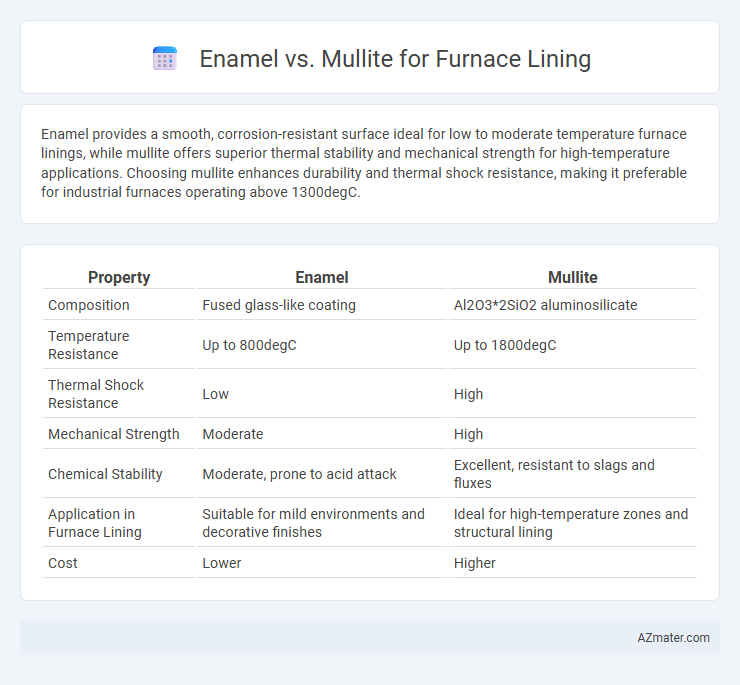Enamel provides a smooth, corrosion-resistant surface ideal for low to moderate temperature furnace linings, while mullite offers superior thermal stability and mechanical strength for high-temperature applications. Choosing mullite enhances durability and thermal shock resistance, making it preferable for industrial furnaces operating above 1300degC.
Table of Comparison
| Property | Enamel | Mullite |
|---|---|---|
| Composition | Fused glass-like coating | Al2O3*2SiO2 aluminosilicate |
| Temperature Resistance | Up to 800degC | Up to 1800degC |
| Thermal Shock Resistance | Low | High |
| Mechanical Strength | Moderate | High |
| Chemical Stability | Moderate, prone to acid attack | Excellent, resistant to slags and fluxes |
| Application in Furnace Lining | Suitable for mild environments and decorative finishes | Ideal for high-temperature zones and structural lining |
| Cost | Lower | Higher |
Introduction to Furnace Lining Materials
Furnace lining materials such as enamel and mullite play a critical role in thermal insulation, chemical resistance, and mechanical strength within high-temperature environments. Mullite is favored for its excellent thermal shock resistance, stability at temperatures above 1700degC, and strong structural integrity, making it ideal for industrial furnace linings. Enamel, though beneficial for its smooth, corrosion-resistant surface and ease of cleaning, typically operates effectively at lower temperatures and is often used as a protective coating rather than a primary refractory material.
Understanding Enamel: Composition and Properties
Enamel for furnace lining is a glassy coating primarily composed of silica, alumina, and various fluxes that fuse onto metal surfaces to provide a smooth, impervious barrier resistant to corrosion and thermal shock. Its chemical stability and high melting point make enamel ideal for protecting furnace interiors from oxidation and chemical attack. The dense, non-porous nature of enamel ensures minimal gas permeability, enhancing durability and longevity in high-temperature environments.
Defining Mullite: Structure and Characteristics
Mullite is an aluminosilicate ceramic with a chemical composition primarily of 3Al2O3*2SiO2, known for its excellent thermal stability and low thermal expansion, making it ideal for high-temperature furnace linings. Its unique orthorhombic crystal structure imparts exceptional mechanical strength and resistance to thermal shock compared to enamel coatings. The inherent refractory properties of mullite enable it to withstand temperatures exceeding 1700degC, providing superior durability and longevity in harsh furnace environments.
Thermal Resistance: Enamel vs Mullite
Mullite offers superior thermal resistance compared to enamel, withstanding temperatures up to 1750degC, making it ideal for high-temperature furnace linings. Enamel, while resistant to moderate heat, typically degrades above 700degC, limiting its use in extreme thermal environments. The exceptional thermal stability and low thermal expansion of mullite reduce the risk of cracking and prolong furnace lining lifespan.
Chemical Stability in High-Temperature Environments
Enamel offers moderate chemical stability in high-temperature furnace linings but is prone to degradation and cracking under prolonged exposure to temperatures exceeding 600degC. Mullite, a robust aluminosilicate ceramic, exhibits superior chemical stability, maintaining structural integrity and resistance to corrosion at temperatures above 1500degC. This makes mullite the preferred material for furnace linings requiring long-term endurance in aggressive, high-temperature environments.
Mechanical Strength and Durability Comparison
Mullite offers superior mechanical strength and durability compared to enamel, making it ideal for furnace linings exposed to high thermal and mechanical stresses. Its excellent resistance to thermal shock and abrasion ensures longer service life in harsh industrial environments. Enamel coatings provide moderate protection but tend to chip and degrade faster under extreme operating conditions.
Installation Process: Enamel vs Mullite Linings
Enamel linings for furnace installations require precise surface preparation and careful application of enamel powder or liquid, followed by controlled firing to achieve a durable, glass-like coating. Mullite linings involve shaping and fitting high-purity alumina-silicate refractory bricks or castables, which are mechanically set and cured for thermal stability and resistance. The enamel process demands skilled handling to prevent cracking during cooling, whereas mullite installation emphasizes joint integrity and thermal expansion compatibility in high-temperature environments.
Cost Analysis and Long-Term Value
Mullite furnace linings offer superior thermal stability and resistance to corrosion compared to enamel, which results in lower maintenance and replacement costs over time. Although enamel linings have a lower upfront cost, their shorter lifespan and susceptibility to cracking increase long-term expenses and downtime. Investing in mullite provides better cost efficiency and durability for high-temperature industrial applications, maximizing long-term value despite a higher initial price.
Suitable Applications for Enamel and Mullite
Enamel linings are ideal for furnaces operating at lower temperatures or involving corrosive chemical environments due to their excellent resistance to chemical attack and ease of cleaning. Mullite, characterized by its high melting point around 1840degC and superior thermal shock resistance, suits high-temperature industrial furnaces such as those used in ceramics, metallurgy, and glass manufacturing. Selecting enamel is advantageous in acidic atmospheres or for equipment requiring smooth, non-porous surfaces, whereas mullite is preferred for structural integrity and long service life in harsh, high-temperature conditions.
Choosing the Best Material for Furnace Lining
Choosing the best material for furnace lining depends on temperature resistance, thermal stability, and chemical compatibility. Mullite offers superior thermal shock resistance and high melting point around 1840degC, making it ideal for high-temperature industrial furnaces. Enamel, while providing good corrosion resistance and smoother surfaces, is generally less durable under extreme thermal cycles compared to mullite.

Infographic: Enamel vs Mullite for Furnace Lining
 azmater.com
azmater.com